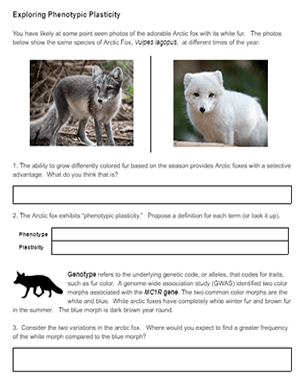
Help your students understand evolution with this worksheet on phenotypic plasticity.
When I ask my biology students to tell me what they know about evolution, they usually tell me that animals adapt to their surroundings. This statement isn’t necessarily wrong, but it’s not completely accurate either. Students often visualize the idea of adaptation as animals blending in to their environment or giraffes stretching their necks to reach leaves.
Misconceptions arise because they don’t fully understand that these evolutionary adaptations occur over time and at a species level. This is different from an animal adapting to winter by growing a thicker coat. The animal may have a thicker coat in the winter, but its underlying genetics have not changed.
In this activity, students learn that arctic foxes have white coats in the winter and brown coats in the summer. This phenomenon is called phenotypic plasticity. The fox’s genes do not change. Though, I should point out, that this plasticity is likely the result of evolutionary forces, but that’s a lesson for another day.
Students then examine a similar scenario in daphnia. These aquatic vertebrates will develop spikes and armor when they detect nearby predators. My students are already familiar with these tiny crustaceans from earlier activities with microscopes and water quality. Here, they revisit the organisms and discuss biological trade-offs. Why wouldn’t all daphnia have armor?
Finally, students apply what they have learned to summarize the difference between evolution by natural selection and phenotypic plasticity. I have also linked to case they may have explored as freshman, natural selection in the rock pocket mouse. I hope that students finally understand the difference between an individual responding to the environment and a population evolving.

